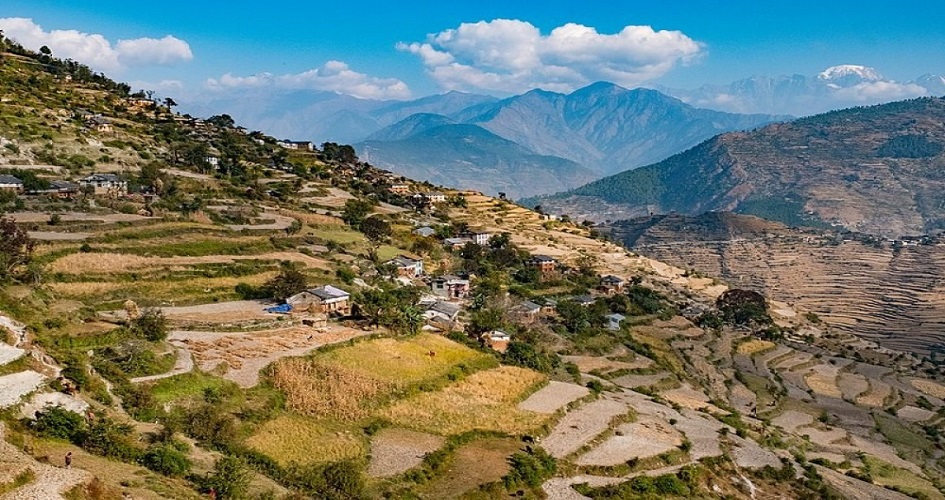Bajhang District is one of Nepal's seventy-seven districts and is located in Sudurpashchim Province. The district, which has its headquarters at Chainpur, which is part of the Jaya Prithvi Municipality, spans 3,422 km2 (1,321 sq mi) and has 195,159 people (2011).
Chainpur is located on the banks of the Seti River and the Bauli Khola. Bitthad Bazar has a boundary with Baitadi District, which includes Bitthad Kalika and Kedar. This location was well-known for its fresh milk and yoghurt.
Introduction To Bahjang District
Bajhang is located in a lovely region of Nepal's far west. Chainpur, the district's headquarters, has a long and illustrious history. Because of the numerous ruins of palaces and forts, it is also known as the city of kings. The area, which is located on the banks of the Seti River, is also recognized for having the best fresh yoghurt and milk.
Travellers will like Bajhang since it has numerous significant religious pilgrimage sites, historical sites, and hiking opportunities.
Natural Beauty Of Bahjang
Snowy mountains such as Saipal Himal, Ramkot Peak, Sankhamala Himal, Lama Peak, and others can be found in Bajhang. The area is noted for its continuous Himalayan paths. Animals such as black bears, hispid hares, wolves, barking deer, blue sheep, and snow leopards may be found in the highlands.
 Owing to its natural beauty, it is an ideal location for adventure trekking. The Yarsagumba is the district's most notable feature. Bajhang has a lot of promise for tourism because of its carved rock faces, magnificent rocks, vast grassland, and lovely lakes.
Owing to its natural beauty, it is an ideal location for adventure trekking. The Yarsagumba is the district's most notable feature. Bajhang has a lot of promise for tourism because of its carved rock faces, magnificent rocks, vast grassland, and lovely lakes.
How Can You Reach Bajhang District?
The Khopde-Bajhang Road, also known as the Jaya Prithivi Bahadur Singh Road, connects Khopde and Bajhang. The route connects the district to the headquarters and runs for 109 kilometres from Khopde to Bajhang.
From Kathmandu to Dhangadhi, and subsequently, from Dhangadhi to Bajhang, buses are accessible. The magnificent vistas on the approximately 19-hour bus trip will leave you speechless.
Places To Visit In Bahjang District
We have enlisted a few places that you should visit during your trip to Bahjang. They are:
- Mount Saipal
- Surmasarovar Lake
- Khaptad Baba Ashram
- Ramkot
Mount Saipal
Mount Saipal, at 7,031 meters, is the second-highest mountain in the Far Western Himalayas. Climbers prefer it over Mount Api because the trekking path to the base camp is less problematic.
 The route continues up to the Urai Bhanjyang pass, the primary entry point to Tibet's sacred Mount Kailash.
The route continues up to the Urai Bhanjyang pass, the primary entry point to Tibet's sacred Mount Kailash.
Surmasarovar Lake
Surmasarowar Lake, at an elevation of 4,300 meters, is located southwest of the Mount Saipal range.
It has medicinal benefits in addition to its natural and historical importance. A plunge in this lake is thought to aid in the healing of skin ailments. There's also the legend that if you do so, the Goddess Surma would be delighted and will assist you in achieving your goals.
 Every year, at the end of July, there is a large festival called Birijaat. During this yearly occasion, thousands of pilgrims come to take a ceremonial bath. The walking path to Surmasarowar is an excellent attraction in and of itself, aside from the lake.
Every year, at the end of July, there is a large festival called Birijaat. During this yearly occasion, thousands of pilgrims come to take a ceremonial bath. The walking path to Surmasarowar is an excellent attraction in and of itself, aside from the lake.
Khaptad Baba Ashram
It is dedicated to Swami Sachita Nanada and is located at the height of 2,923 meters above sea level. The ashram is surrounded by beautiful natural surroundings and a diverse array of fragrant and medicinal plants.
 The ideal seasons to visit are fall and spring when the weather complements the area's natural splendour.
The ideal seasons to visit are fall and spring when the weather complements the area's natural splendour.
Ramkot
Ramkot offers spectacular views of the Himalayan peaks of Saipal, Gorakh, Urailekh, Kanti, Surmalekh, and Kanjirowa to the north, west, and east, as well as a lovely meandering Seti River valley with general population villages and wreaths of mountain-skylines to the south.
The path from Talkot Dhuli to Ramkot along the river valley is spectacular. Basic views include fowls and creepy crawlies, the main population's rudimentary way of life, hovels and covered rooftop homes enlivened by brilliant mud.
Geologists can investigate how the mountains are arranged. The easiest way to go to Kailash and Man Sarovar in Tibet is to travel through the Chanwa Urailekh valley via the Seti River.















